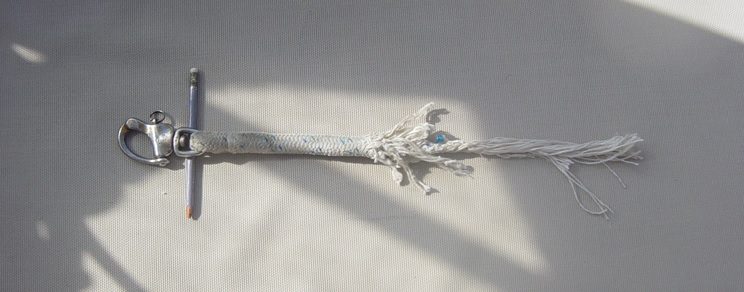Changing Tires
Hello landlubbers,
We are now within 28 miles of the Marquesas
and should see land by sunset! Very exciting.
1630, May 4th
South 09 Deg 43′ West 138 Deg 16′
Journal entry from Sunday:
Sunday, May 2, 2004:
S 09o24′
W 124o17′
(Day 20 at sea: 2701 nautical miles from the Galapagos Islands, 265 from
Les Isles Marquises)
This journal entry comes at the end of a midnight watch, under ideal sailing conditions. The moon is near full with crystal clear air and scattered clouds. The rain from earlier this evening has passed to the west, and Lillian B. is moving at a brisk 6.5 knots under staysail and spinnaker, with only a slight rolling motion. This is a very welcomed change from recent days, when our patience has been tested. The second half of the passage has included a fair amount of uncomfortable sailing conditions. I am curious as to whether these are typical trade wind conditions, or whether they are more like the unsettled weather normally attributed to the Inter Tropical Convergence Zone (ITCZ). The largest aggravation is still the waves whenever they overpower wind and sails. I begin to image the Pacific as a very large bathtub with waves reflecting back and forth off far shores. Lillian rocks, sails bang, and pots of food and coffee go flying across the galley, spilling contents into unreachable crevices. These are admittedly minor aggravations, but they begin to add up as we curse the waves with little effect. It is not boredom as much as a form of water torture that arrives in large swells instead of tiny droplets.
We are fortunate in being a crew who share the chores (such as cleaning up spilled coffee grounds) and who have only themselves to blame for being out in the middle of the rolling Pacific. Such is not the case for all. A week ago, at sunset, the twin masts of a yawl passing us to the south could be seen poking above the horizon. Shortly afterwards came a call over the radio. “Hello, this is the Bijouden Blue calling the sailboat to our right, come in please.” The accent was definitely French, and I was imagining Leslie Carrone (sp?) from the Cary Grant film “Father Goose” on the other end of the receiver. After exchanging, “Bon Soir’s” we compared notes on where we’d come from, how long we’d been at sea, and where we were going. Mainly, however, she wanted to let us know how truly glad they were that they had seen another boat. She explained that they had two children on board who were very impatient to get to land. If I had been Father Goose, I’m sure I’d have offered a comment about the wisdom of having children on board a sailboat for 20 days straight. Instead, I simply passed on our sincere sympathies and wished them best of luck. We were nearly as glad to see them, and I don’t think either of us wanted to break the link between boats. But after ten minutes or so we signed off and returned to our respective routines.
It is the routine of the watch schedule and associated chores that help to pass the time. These activities, however, include sail changes that are frustrating when they have to be repeated often in response to rapidly changing weather. The aggravation is compounded by equipment problems. Last night a squall hit resulting in another all hands on deck exercise to lower the spinnaker. Once it was down, inspection of the halyard used to raise it to the top of the mast revealed that a protective sheath had worn through. It was chaffing at the masthead in the same manner that had caused the primary spinnaker halyard to fail back on April 19th, dropping the sail in the water and leaving Lillian with only a secondary halyard to raise the spinnaker. After that first incident, we adopted Dick’s suggestion to protect the critical section of our remaining halyard by ensheathing it in a length of rubber tubing. During last night’s squall, that protective sheath had worn through. It needed to be fixed immediately and the spinnaker re-set to maintain speed, or else we would be in for a long low-speed night of rocking and rolling. Duct tape was the quick, if not elegant, solution.

With this current cycle of light air and squalls, we find ourselves constantly changing sail configurations and frequently lowering and raising the sails to monitor the health of halyards and sheets. By analogy, it would be similar to being on a crosscountry automobile trip and having to stop every half-an-hour to change tires. In the worst-case scenario, that would be a 3000 mile road trip, on a very bumpy road, at 6 miles per hour. Fortunately, the weather does change and the road does have an end. Our destination is now less than 265 miles away.